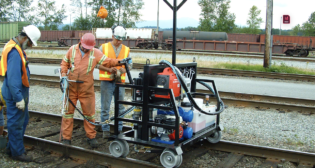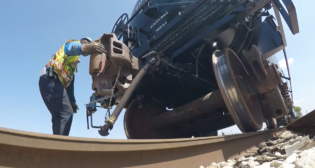
GZA’s SJG/Conrail environmental success story
Written by Peter J. HoweAcross the United States, gas utilities have been confronting the problem of remediating the environmental impacts of hundreds of former Manufactured Gas Plants (MGPs). Up until the late 1940s, at these plants, coal was converted into coal gas, which was primarily used for cooking and lighting until it was supplanted by much cleaner natural gas.
The byproducts left behind from creating coal gas, however, include volatile and semi-volatile environmental contaminants that utilities and their ratepayers have spent hundreds of millions of dollars to clean up to keep soil and groundwater safe.
Recently, South Jersey Industries’ SJG unit completed remediation work at an MGP site in Glassboro, N.J., that came with a unique problem: An 85-foot-deep underground containment wall had to be constructed directly alongside several hundred feet of an active Conrail line—and then cut across the railroad at two separate locations, all without jeopardizing the soil-bearing requirements necessary to support heavy freight trains.
Making it all the more complex for SJI and its consulting engineers from GZA GeoEnvironmental Inc.: Conrail allowed just two 60-hour windows of time on two weekends for removing track, building the new containment wall across its right-of-way, and getting the track reinstalled and ready for service on a Monday morning.
Close by the construction site were the homes of 12 families who had to be either relocated for the weekend, or placated during loud, 24-hour-a day work under bright lights.
“GZA and the contractors clearly understood the critical importance of getting the line back in service to meet Conrail’s schedule,’’ Conrail Project Engineer Vincent Milano said. “Really, our goal here is, you want to continue train operations as normally as possible, and they did it. They actually did a little better than the schedule. GZA was definitely positive and responsive.’’
Agreed SJG Environmental Manager Ken Sheppard: “This was definitely a win. It was a monumental lift, but it was so well communicated up-front, and then if anything over-communicated when the work was under way. The benefit was that we wound up getting zero complaints from folks in the area.” That included no complaints even from families living nearby who passed on the chance to check in to the Courtyard by Marriott for the weekend and stayed in their homes through two weekends of intense construction activities.
GZA Senior Vice President Joe Foglio said this was an example of a project where “planning and cooperation of the all the parties involved—Conrail, the Borough, the residents, SJG, the contractor, and the GZA team—was critical to executing the project with success. When those 60-hour windows for construction work opened, we needed to have everyone on the team completely ready to go, with an hour-by-hour roadmap of who would be doing what and when. We also had extensive fallback plans for contingencies or anything unexpected.”
The project involved building a deep soil mix (DSM) wall to control the spread of groundwater from a former MGP site now owned by SJG. The construction process required erection of a 90-foot-tall DSM rig, removal of 80 feet of Conrail track on the two weekends, and the installation of five poured-concrete panels across the rail right-of-way, each 3 feet thick, 10 feet long, and 85 feet deep. Conrail subcontractors, in coordination with GZA and SJG and their contractors, then re-laid pre-fabricated panels of track to reconnect the line.
The affected stretch is part of the former Pennsylvania-Reading Seashore Lines route from Philadelphia to Atlantic City and is used by Conrail to serve a variety of industrial and commercial customers.
Foglio said GZA demonstrated through geotechnical instrumentation data that the track moved less than half an inch during and following construction of the DSM wall, well within railroad operating tolerances. . “Fortunately,’’ GZA’s Foglio said, “and thanks to all the planning we did, the nice surprise was having no surprises.”
Peter J. Howe, a former Boston Globe and New England Cable News Reporter, is Senior Advisor with Denterlein, a Boston-based strategic communications consulting firm that works with GZA GeoEnvironmental.



